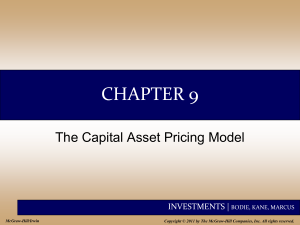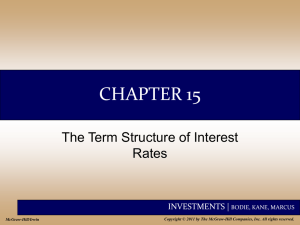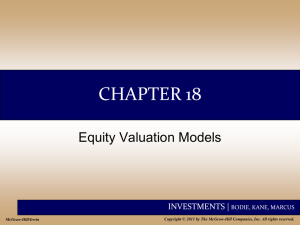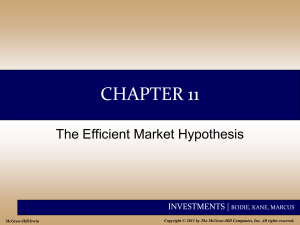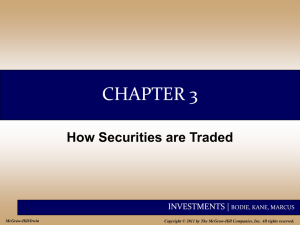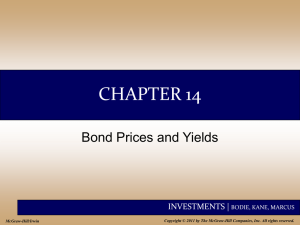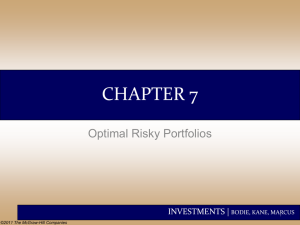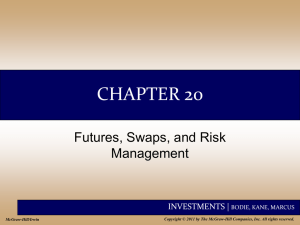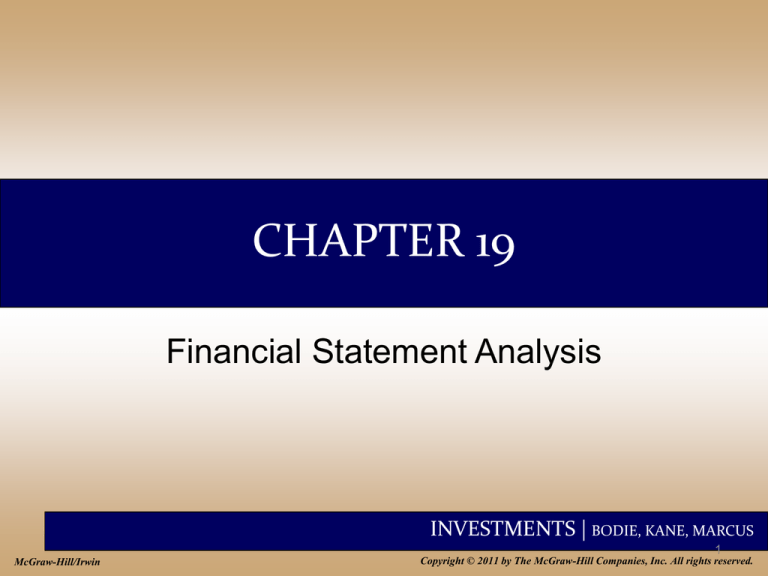
CHAPTER 19
Financial Statement Analysis
INVESTMENTS | BODIE, KANE, MARCUS
1
McGraw-Hill/Irwin
Copyright © 2011 by The McGraw-Hill Companies, Inc. All rights reserved.
19-2
Financial Statement Analysis
• Financial statement analysis can be
used to discover mispriced securities.
• Financial accounting data are widely
available, but
– Accounting earnings and economic
earnings are not always the same thing!
INVESTMENTS | BODIE, KANE, MARCUS
2
19-3
Financial Statements
• Income Statement:
– Profitability over time
• Balance Sheet:
– Financial condition at a point in time
• Statement of Cash Flows:
– Tracks the cash implications of
transactions.
INVESTMENTS | BODIE, KANE, MARCUS
3
19-4
Table 19.1 Consolidated Statement of
Income for Hewlett-Packard, 2009
INVESTMENTS | BODIE, KANE, MARCUS
4
19-5
Table 19.2 Consolidated Balance Sheet for
Hewlett-Packard, 2009
INVESTMENTS | BODIE, KANE, MARCUS
5
19-6
Table 19.3 Statement of Cash Flows for
Hewlett-Packard, 2009
INVESTMENTS | BODIE, KANE, MARCUS
6
19-7
Accounting Versus Economic Earnings
• Economic earnings
– Sustainable cash flow that can be paid
to stockholders without impairing
productive capacity of the firm
• Accounting earnings
– Affected by conventions regarding the
valuation of assets
INVESTMENTS | BODIE, KANE, MARCUS
7
19-8
Profitability Measures
• ROE measures profitability for
contributors of equity capital.
– After-tax profit/book value of equity
• ROA measures profitability for all
contributors of capital.
– EBIT/total assets
INVESTMENTS | BODIE, KANE, MARCUS
8
19-9
Past vs. Future ROE
• ROE is a key determinant of earnings
growth.
• Past profitability does not guarantee future
profitability.
• Security values are based on future
profits.
• Expectations of future dividends determine
today’s stock value.
INVESTMENTS | BODIE, KANE, MARCUS
9
19-10
Financial Leverage and ROE
• ROE can differ from ROA because of
leverage.
• Leverage makes ROE more volatile.
• Let t=tax rate and r=interest rate, then:
Debt
ROE 1 t ROA ROA r
Equity
INVESTMENTS | BODIE, KANE, MARCUS
10
19-11
Financial Leverage and ROE
Debt
ROE 1 t ROA ROA r
Equity
• If there is no debt or ROA = r, ROE will
simply equal ROA(1 - t).
• If ROA > r, the firm earns more than it pays
out to creditors and ROE increases.
• If ROA < r, ROE will decline as a function
of the debt-to-equity ratio.
INVESTMENTS | BODIE, KANE, MARCUS
11
19-12
Table 19.5 Impact of Financial
Leverage on ROE
INVESTMENTS | BODIE, KANE, MARCUS
12
19-13
Decomposition of ROE
DuPont Method
ROE =
Net Profit
x
Pretax Profit
Burden
x
EBIT
(1)
Tax
Pretax Profit
x
x
(2)
Interest
Burden
x
EBIT
Sales
(3)
x
x
Sales
Assets
(4)
x
Assets
Equity
x (5)
x Margin x Turnover x Leverage
INVESTMENTS | BODIE, KANE, MARCUS
13
19-14
Decomposition of ROE
ROA=EBIT/Sales X Sales/Assets
= margin X turnover
• Margin and turnover are unaffected by
leverage.
• ROA reflects soundness of firm’s
operations, regardless of how they are
financed.
INVESTMENTS | BODIE, KANE, MARCUS
14
19-15
Decomposition of ROE
ROE=Tax burden X ROA X Compound leverage
factor
• Tax burden is not affected by leverage.
• Compound leverage factor= Interest
burden X Leverage
INVESTMENTS | BODIE, KANE, MARCUS
15
19-16
Table 19.6 Ratio Decomposition Analysis
for Nodett and Somdett
INVESTMENTS | BODIE, KANE, MARCUS
16
19-17
Choosing a Benchmark
• Compare the company’s ratios across
time.
• Compare ratios of firms in the same
industry.
• Cross-industry comparisons can be
misleading.
INVESTMENTS | BODIE, KANE, MARCUS
17
19-18
Table 19.7 Differences between Profit Margin
and Asset Turnover across Industries
INVESTMENTS | BODIE, KANE, MARCUS
18
19-19
Table 19.9 Summary of Key Financial
Ratios
INVESTMENTS | BODIE, KANE, MARCUS
19
19-20
Table 19.9 Summary of Key Financial
Ratios
INVESTMENTS | BODIE, KANE, MARCUS
20
19-21
Table 19.9 Summary of Key Financial
Ratios
INVESTMENTS | BODIE, KANE, MARCUS
21
19-22
Table 19.9 Summary of Key Financial
Ratios
INVESTMENTS | BODIE, KANE, MARCUS
22
19-23
Table 19.9 Summary of Key Financial
Ratios
INVESTMENTS | BODIE, KANE, MARCUS
23
19-24
Figure 19.1 DuPont Decomposition for
Hewlett-Packard
INVESTMENTS | BODIE, KANE, MARCUS
24
19-25
Economic Value Added
• EVA is the difference between return on
assets (ROA) and the opportunity cost of
capital (k), multiplied by the capital
invested in the firm.
• EVA is also called residual income
• If ROA > k, value is added to the firm.
INVESTMENTS | BODIE, KANE, MARCUS
25
19-26
Example 19.4 Wal-Mart
• In 2009, Wal-Mart’s cost of capital was
5.9%. Its ROA was 9.6% and its capital
base was $115 billion.
• Wal-Mart’s EVA =
(0.096-0.059) x $115 billion = $4.25 billion
INVESTMENTS | BODIE, KANE, MARCUS
26
19-27
Comparability Problems
• Accounting Differences
– Inventory Valuation
– Depreciation
• Inflation and Interest Expense
• Fair Value Accounting
• Quality of Earnings
• International Accounting Conventions
INVESTMENTS | BODIE, KANE, MARCUS
27
19-28
International Accounting Differences
• Reserves – many other countries allow
more flexibility in use of reserves
• Depreciation – US allows separate tax
and reporting presentations
• Intangibles – treatment varies widely
INVESTMENTS | BODIE, KANE, MARCUS
28
19-29
Figure 19.2 Adjusted Versus Reported
Price-Earnings Ratios
INVESTMENTS | BODIE, KANE, MARCUS
29
19-30
The Graham Technique
• Rules for stock selection:
– Purchase common stocks at less than
their working-capital value.
– Give no weight to plant or other fixed
assets.
– Deduct all liabilities in full from assets.
INVESTMENTS | BODIE, KANE, MARCUS
30


